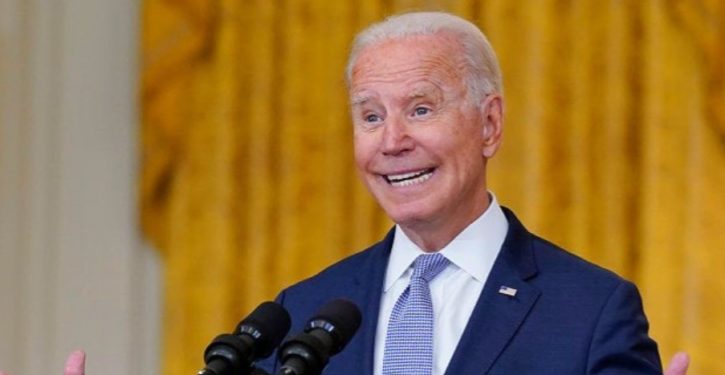
A recent lawsuit illustrates yet again that the Biden administration makes false claims without evidence.
On June 4, the Biden administration issued a notice calling for new federal policies about school discipline, in light of the fact that “students of color” are disciplined more often than “their White peers.” It cited a controversial report by the U.S. Commission on Civil Rights “finding that: Students of color as a whole, as well as by individual racial group, do not commit more disciplinable offenses than their white peers.”
But as a Washington Post news reporter noted in 2019, the Commission never showed that “finding” was true. The Commission’s chairwoman, who is now President Biden’s nominee to head the Education Department’s Office for Civil Rights, “pointed to a few spots” in the Commission’s report to “claim that there are no underlying differences in student behavior. But those citations did not offer such evidence. One set of data referenced in the report showed the opposite,” noted The Post’s Laura Meckler.
Moreover, studies and surveys show that black students do have higher rates of misbehavior in school. Data from the National Center for Education Statistics shows blacks are much more likely than whites to get into fights at school — 11.4% of blacks did so, compared to 5.2% percent of whites, according to the Education Department’s NCES Indicators of School Crime and Safety: 2016.
What, then, was the Education Department’s basis for making this claim? A recent lawsuit suggests it had no evidence for this sweeping claim about “students of color” having exactly the same misbehavior rate as their “white peers.”
On May 21, Liberty Unyielding and the Bader Family Foundation sent the Education Department a request under the Freedom of Information Act for emails between high-ranking Education Department officials and several people (such as lawyers, activists, and academics) who write about school discipline. The Education Department failed to issue a determination in response to that request, in violation of FOIA’s 20-day deadline. So it was sued on June 30. The complaint can be found at this link.
On August 30, the Education Department finally produced some of the requested emails. The emails show that the Education Department should have known better than to claim that students of color don’t commit more disciplinable offenses than their white peers.
First, the emails produced show that the Education Department was aware of the School Safety Commission report, which cited research finding that school misbehavior rates differ by race. A highlighted portion of that report notes that “researchers” had “analyzed the specific circumstances underlying these suspensions and discovered that ‘the racial gap in suspensions was completely accounted for by a measure of the prior problem behavior’ of the student.” An unhighlighted portion of that report points out that
research studies reveal that black youth, in comparison with their white counterparts, are … disproportionately involved in delinquency and crime (Earls, 1994; Hawkins, Laub, & Lauritsen, 1998), and are more likely to behave in ways that interfere with classroom and school functioning (Beaver, Wright, & DeLisi, 2011). These studies, and others from various disciplines, suggest that the school disciplinary rates may also reflect the problematic behaviors of black youth—problem behaviors that are imported into schools and into classrooms.
The highlighted passages were highlighted by Professor Russell Skiba, in an attachment to his May 28, 2021 2:25 AM email to Carolyn Seugling of the Education Department’s Office for Civil Rights and James Eichner of the Justice Department’s Civil Rights Division. The Education Department sought out Skiba’s advice.
Skiba notes that the School Safety Commission report is “highlighted with a corresponding comment” from Skiba at various places. But the Education Department failed to turn over Skiba’s comments along with the highlighted text it corresponds to, so what Skiba said in response to these passages of the School Safety Commission report is an enigma. (In withholding these comments, the Education Department violated FOIA, perhaps inadvertently. Yesterday, I asked it to turn over the comments, but have gotten no response yet.).
Skiba does not appear to have taken issue with the passage saying that “research studies reveal that black youth, in comparison with their white counterparts, are … disproportionately involved in delinquency and crime … and are more likely to behave in ways that interfere with classroom and school functioning.” Skiba has taken issue with the idea that the racial gap in suspensions is “completely accounted” for by racial differences in behavior.
But Skiba himself does not claim that “students of color as a whole” have the exact same rate of misbehavior as whites, in the emails produced by the Education Department. Indeed, in his remarks at a May 11 Education Department event, Skiba admitted that rates of student misbehavior play a role in racial disparities in school discipline rates (although he argued that rates of student misbehavior were not among the top two factors driving such disparities. He argued on May 11 that racial disparities in discipline rates are caused more by other factors, such as school-to-school differences in discipline policy (such as harsher discipline at high-poverty, heavily non-white schools), and racial bias.
Moreover, Skiba’s email approvingly encloses an academic article that undercuts the idea that “students of color as a whole” have exactly the same misconduct rate as their white peers. (See Welsh & Little, The School Discipline Dilemma, 88 Review of Educational Research 752 (2018)).
That article states:
The extant literature suggests that the rates of and disparities in exclusionary discipline outcomes are multiply determined, local, multifaceted, and complex (Skiba, Chung, et al., 2014). No single factor explains the discipline disparities as empirical evidence indicates that student behavior, student characteristics, and school-level variables all contribute to disciplinary outcomes… there is little empirical evidence to substantiate the notion that discriminatory behavior by teachers and school leaders is a significant driver of discipline disparities. Some scholars have highlighted that although there is evidence that school-level policies and practices contribute to the rates of and disparities in exclusionary discipline outcomes, the evidence concerning correlations between discipline practices and racial bias and discrimination is inconclusive.
On the other hand, that article later says that research raises “doubts about misbehavior as the primary contributor to the rates of and disparities in disciplinary outcomes ” and suggests that higher black discipline rates cannot be explained simply by higher rates of black misbehavior.
Michael Petrilli, who helped create the Education Department’s Office of Innovation, points out that there are large racial differences in school misbehavior rates, according to students themselves. As Petrilli noted in Education Next, “In 2015, high school students were asked if they had been in a fight on school property at any time in the past 12 months. African American students were 2.2 times more likely to say yes than white students.”
There are obvious socioeconomic reasons for black students to misbehave at a higher rate than white students. As the liberal Brookings Institution pointed out in 2017, “black students are also more likely to come from family backgrounds associated with school behavior problems” including “single-parent families.”
Because misbehavior rates are not the same for different racial groups, requiring schools to suspend all racial groups at the same rate is an illegal racial quota. In 1997, an appeals court overturned a rule requiring a school district not “to refer a higher percentage of minority students than of white students for discipline unless the district purges all ‘subjective’ criteria from its disciplinary code.” It ruled such “racial disciplinary quotas” are illegal, and “violate equity in its root sense. They entail either systematically overpunishing the innocent or systematically underpunishing the guilty.” (People Who Care v. Rockford Board of Education, 111 F.3d 528, 538 (7th Cir. 1997)).



